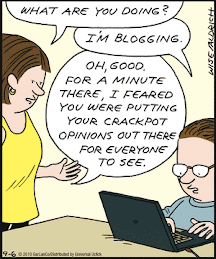Graphs to follow, but first, let's have a look at what a bubble is, from Markus Brunnermaier, quoted in this post by Gavyn Davies at FT Blogs. [No pay wall, but you'll have to register to read it.]
Bubbles are typically associated with dramatic asset price increases followed by a collapse. Bubbles arise if the price exceeds the asset’s fundamental value. This can occur if investors hold the asset because they believe that they can sell it at a higher price to some other investor even though the asset’s price exceeds its fundamental value.
This is pretty good, but there's something missing. How do you assess fundamental value? With housing, you can make some comparison to cash flow from comparable rentals, but that's an approximation, and comparables never quite are. Plus there's the location-location-location aspect that always tells you your house is worth more than the one a quarter mile away.
But, via Mish, Graph 1 displays how a home prices index diverged from a rental index.
Graph 1 Home Price Index vs Rents
Instead of tracking together, prices ballooned to about 3 times the rental equivalent before crashing. Besides this divergence per se, the other visual feature of a bubble is the price chart going parabolic. It's a thrill ride, for sure, until the stomach-wrenching drop.
So, back to the C-S Index. Values are inflation adjusted, and given in constant 2013 dollars. I graphed the data from 1900 forward. It's presented as Graph 2.
Graph 2 Case-Shiller Index, 1900 on
A few things stand out.
1 - The long average, 126.0 [yellow] is nearly identical to the 1953 -2000 average, 124.0 [purple.]
2 - From 1917 through the Great Depression, housing price stayed low and mostly flat.
3 - The first big rise in home values was from 1942 to 1947, roughly the span of WW II.
4 - From 1953 to 2000, the Index stayed within a fairly narrow range.
5 - The bubble inflated from 2000 until it burst in 2005.
Graph 3 presents a close up view of the 1953-on period.
Graph 3 Case-Shiller Index, 1950 on
I've added a blue band +/- 2 Standard Deviations [St Dev = 6.2] around the 1953 to 2000 average. Except for a brief and quickly corrected span in 1988-9, the Index stayed within the +/- 2 St Dev envelope until 2000. From there the rise is nearly vertical to 221.41 in Q4 '05. The decline is just as dramatic, hitting right on the long average of 126 in Q1 '12.
The rise to the peak tops out at 15.6 standard deviations from the 47 year mean.
I've also added a trend channel in red and green, with a width of 19.04 index units, based on the series of increasing bottoms starting in Q3 '74. The channel top is parallel to the bottom, and projected from the Q1 '79 top. The bubble peak is 5.12 channel widths above the channel bottom.
Graph 2 indicates 3 long realms of relatively stable housing prices, separated by transition periods of only a few years each. One can always quibble about start and end dates, but I parse it out this way.
The question is - where is this going now? Relative to rents, home prices look about right. Relative to either the pre-bubble period or the post '74 trend channel, prices are currently on the high side. If this assessment is correct, then prices should top in the next year or so, then slide during the following 3 to 4 years to near 126, the trend channel bottom, or possibly lower. The other possibility is that post-bubble, we're entered a another different realm, where housing prices will be higher than in the pre-bubble period.
That would be very strange post-bubble behavior.
Update [1/25]
Plus, we now learn that that the pace of sales fell off sharply in December, and that low end [read affordable] properties are being scooped up by hedge funds and other investors paying cash. This, combined with stagnating wages and continuing debt overhang, especially from student loans, is driving first time buyers out of the market.
I don't see this coming to a good end.



![[Most Recent Quotes from www.kitco.com]](http://www.kitconet.com/charts/metals/gold/tny_au_xx_usoz_4.gif)


No comments:
Post a Comment